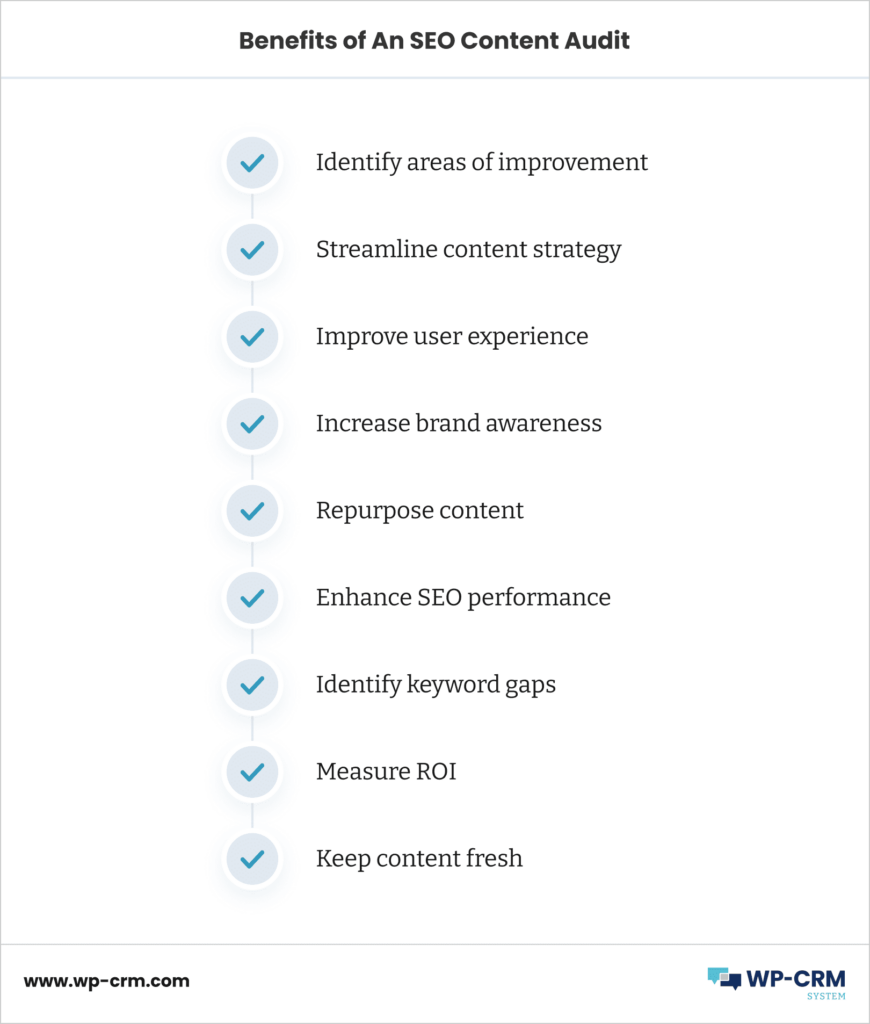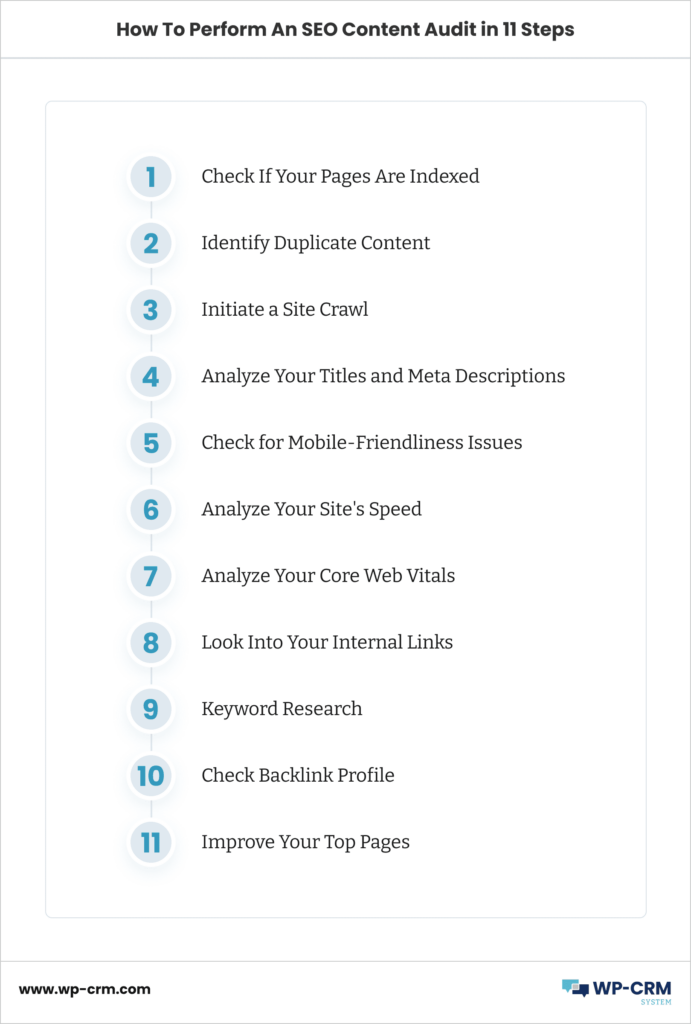How To Conduct An SEO Content Audit
No matter how much experience you have as an SEO professional and content writer, sometimes your work simply doesn’t strike out.
Imagine if you choose a trendy topic, pour your heart and knowledge into it, spend hours in research, only to see your piece buried under other posts on SERPs, without any noticeable difference!
We’ve all been there, and this is hardly a reason to get discouraged! Just the opposite – hone into deep analysis of your website pages that underperform to put your finger on what went wrong. Then, correct it, and create stronger copy as a result. And this requires an SEO content audit.
Sounds quite daunting – uncovering all issues across your site pages that need improving, but we got you! In this article, we will explain more about what SEO content audit is all about, its benefits, necessary steps to do it right, and some tools to help you out.
What Is An SEO Content Audit?
An SEO content audit is a process of analyzing the existing content on a website to boost its search engine optimization (SEO) performance. This helps identify areas of improvement in content quality, keyword targeting, user engagement, and overall effectiveness.
You are not restricted to blog articles only. In fact, you can (and should) audit all content on your website – web pages, landing pages, videos, whitepapers, infographics, product descriptions and so on.
The goal of an SEO content audit is to enhance the website’s ranking on search engines like Google, Bing, and Yahoo. This is achieved by developing high-quality copy that is optimized for target keywords and user intent.
During an SEO content audit, the content is evaluated against a set of criteria, including on-page and off-page factors. On-page factors include elements that are directly visible on the website, such as content quality, title tags, meta descriptions, and internal linking. Off-page factors, on the other hand, include social media shares, backlinks, and other external factors that impact the website’s rankings.
Why Is A Content Audit Useful?

Apart from the obvious reason an SEO content audit is good – improving the quality of your content and its online performance, it is necessary evil because of so much more. It helps you:
- Identify areas of improvement. A content audit helps businesses to analyze the quality and relevance of their existing content. By doing so, they can identify the pieces that need updating or removal, and which ones to keep.
- Streamline content strategy. A content audit enables businesses to develop an effective content strategy that resonates with their target audience. The process involves analyzing the types of content that perform well, identifying gaps, and creating a plan to meet their goals.
- Improve user experience. Analyzing the performance of existing content helps businesses to improve the overall user experience on their website. This way, they can boost engagement metrics such as time on site and bounce rate.
- Increase brand awareness. A well-crafted content marketing strategy can increase brand awareness and build trust with customers, leading to more conversions and sales.
- Repurpose content: A content audit uncovers opportunities for repurposing existing content into new formats. This way, you can reach new audiences without creating entirely new content from scratch.
- Enhance SEO performance. By improving the quality of existing content, businesses can boost their SEO performance and drive more traffic to their website.
- Identify keyword gaps. A content audit enables businesses to identify gaps in their keyword targeting strategy, allowing them to optimize their content for specific keywords and phrases.
- Measure ROI. Having an in-depth look into performance of existing content allows businesses to measure the ROI of their content marketing efforts. By understanding which pieces of content are driving conversions and sales, they can allocate their resources more effectively.
- Keep content fresh. Conducting regular content audits ensures that the website’s content stays fresh and up-to-date. This is important because search engines prioritize websites with fresh, relevant content. Hence, users are more likely to engage with content that is current and timely.
How To Perform An SEO Content Audit in 11 Steps

- Check If Your Pages Are Indexed
- Identify Duplicate Content
- Initiate a Site Crawl
- Analyze Your Titles and Meta Descriptions
- Check for Mobile-Friendliness Issues
- Analyze Your Site’s Speed
- Analyze Your Core Web Vitals
- Look Into Your Internal Links
- Keyword Research
- Check Backlink Profile
- Improve Your Top Pages
Check If Your Pages Are Indexed
The first step in a content audit is to check if search engines have indexed all your website pages. You can do this by performing a site:domain.com search on Google. This will show you all the pages that Google has indexed from your website. If you find that some of your pages are not indexed, you should investigate the reasons why. Common reasons include duplicate pages, low-quality content, or technical issues such as broken links or redirects.
Identify Duplicate Content
Search engines penalize websites that have duplicate content. Therefore, it’s essential to check your website for duplicate content and fix any issues that arise. You can use tools such as Copyscape to identify instances of duplicate content, and then take steps to remove or consolidate those pages.
Initiate a Site Crawl
Site crawls are a key part of a content audit. They help you identify technical issues such as broken links, redirect chains, and missing meta descriptions. You can use tools such as Screaming Frog or SEMrush to perform site crawls and gather data on technical issues that need fixing.
Analyze Your Titles and Meta Descriptions
Titles and meta descriptions are essential components of on-page SEO. They tell search engines what your pages are about and what keywords they should rank for. So, review your titles and meta descriptions as part of your content audit. You should make sure that your they accurately reflect the content of your pages and include target keywords.
Check for Mobile-Friendliness Issues
Mobile-friendliness is a crucial factor in search engine ranking, as more and more people use mobile devices to access the internet. Therefore, it’s important to check if your website is mobile-friendly as part of your content audit. You can use tools such as Google’s Mobile-Friendly Test to identify any issues with your website’s mobile performance.
Analyze Your Site’s Speed
Slow loading times can negatively impact user experience and search engine performance. Make sure you analyze your website’s page speed as part of your content audit. You can use tools such as Google’s PageSpeed Insights or GTmetrix to identify speed issues and take steps to fix them.
Analyze Your Core Web Vitals
Core Web Vitals are a set of metrics that help website owners and marketers understand the key aspects of user experience. These include loading times, interactivity, and visual stability. Analyzing your website’s core web vitals as part of your content audit can help you identify areas of improvement that will enhance user experience and search engine performance.
Look Into Your Internal Links
Internal links are important for on-page SEO, as they help search engines understand the structure of your website and how pages relate to each other. Analyze your internal links to ensure that they are relevant, informative, and help users navigate your website.
Keyword Research
SEO content audit helps you find new keyword ideas that you can use to optimize your existing content or create new content. You can use tools such as Google Keyword Planner or SEMrush to find keyword ideas related to your business or industry.
Check Backlink Profile
Backlinks are signals that your website is authoritative and trustworthy. So, identify any low-quality or spammy links that could harm your website’s performance. You can use tools such as Ahrefs or SEMrush to analyze your backlink profile and take steps to remove or disavow harmful links.
Improve Your Top Pages
Finally, you should focus on your top-performing pages. These pages are likely generating the most traffic and engagement on your website. Therefore, it’s important to analyze these pages in detail and take steps to improve them further. This might include updating the content, optimizing for new keywords, or improving the user experience.
In Conclusion
An SEO content audit helps you keep your website content on point and improve the rankings of your pages. If done regularly and with the right tools, it can also be a useful practice to boost user experience, brand awareness, and ROI.
